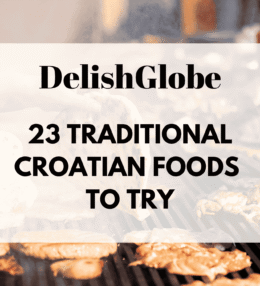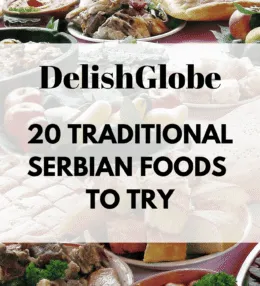Mention Russian cuisine to someone unfamiliar with it, and you might get a puzzled look or a half-hearted guess about borscht. But there’s far more simmering under the surface. Russian cooking is rooted in a land of extremes, frigid winters, sprawling forests, Orthodox fasting traditions and a complex tapestry of ethnic influences that stretch from Europe to Asia. It’s a cuisine built on resilience, ritual and remarkable depth.
This article isn’t just a roll call of dishes; it’s a gateway into the heart of Russian life. Each bite tells a story: of tsars and peasants, of communal tables and sacred seasons. We’ll explore the familiar and the forgotten, from hearty soups to delicate pastries, revealing how Russian food reflects centuries of adaptation and tradition, not simply what’s on the plate but what it meant to gather around it. Let’s take a seat at that table.
Beef Stroganoff (Beef in Creamy Sauce)
Beef Stroganoff is a dish that feels both refined and familiar, offering slow cooked comfort wrapped in creamy elegance. It is a Russian classic that has made its way onto tables around the world, beloved for its balance of richness and warmth.This is not fast food. It is a meal that takes its time, where tender beef is seared then gently simmered in a creamy sauce until each bite melts with flavour. Often served with buttered noodles or rice, it is built to satisfy fully.What makes Beef Stroganoff stand out is its character. It carries the weight of old-world kitchens while still fitting into modern plates. Whether cooked at home or ordered in a restaurant, it always feels like a proper meal. Get The Recipe Syrniki (Cottage Cheese Pancakes)
Syrniki are the kind of breakfast dish that feels like a quiet reward. Golden, crisp edged pancakes made from cottage cheese, they’re soft in the centre, slightly sweet, and often served with sour cream, jam, or honey. In Russia and much of Eastern Europe, they are a morning favourite.Unlike heavier pancakes or overly sweet desserts, Syrniki walk the line between indulgent and comforting. They are rich without being heavy, familiar but distinct. Often made fresh at home, they carry the warmth of family kitchens and quiet weekend mornings.They may look simple, but Syrniki are anything but dull. Their texture, flavour, and cultural ties give them a lasting place at the breakfast table, not just in Russia, but anywhere you find people craving something handmade and heartfelt. Get The Recipe Napoleon Cake (Puff Pastry Cake)
Russian Napoleon Cake is not the sort of dessert you rush through. Each forkful carries thin layers of flaky pastry softened by smooth custard cream, offering a balance of texture and flavour that lingers longer than expected.It is rich without being heavy and layered without feeling fussy. Served during birthdays, holidays, or family gatherings, it holds its place as one of Russia’s most loved and recognisable cakes, cherished across generations.Its charm lies in the contrast. The crisp pastry crackles under the pressure of the fork, while the custard melts across the tongue. The longer it rests in the fridge, the more the flavours settle into a single, indulgent slice. Get The Recipe Vatrushka (Cottage Cheese Pastry)
Vatrushka is one of those quiet staples of Russian baking that feels both rustic and inviting. This round, open-faced pastry with a creamy cottage cheese filling sits somewhere between dessert and breakfast, offering a gentle sweetness wrapped in soft, yeasted dough.It is the kind of pastry often found in bakeries, home kitchens, and school lunch bags across Russia and Eastern Europe. Not overly sweet, not overly rich, it carries a balance that invites second helpings without ever being showy.Its charm lies in its simplicity. There is nothing elaborate here, just a well-made dough cradling a cheese mixture that tastes of comfort. Whether served with tea or eaten on the go, Vatrushka feels familiar from the very first bite. Get The Recipe Kurnik (Russian Chicken Pie)
Kurnik is no ordinary pie. Sometimes called the tsar’s pie, this dome shaped baked dish has long held a special place in Russian celebrations. Filled with layers of chicken, mushrooms, rice, and eggs, it is a feast wrapped in pastry.While hearty enough for winter gatherings, Kurnik also carries a festive charm that makes it perfect for weddings, holidays, or big family meals. Its golden crust and layered filling offer a generous slice of comfort and tradition.Rich but not overwhelming, Kurnik captures the kind of food that was made to bring people together. It tells a story from the first flaky bite to the last savoury mouthful, holding both warmth and elegance. Get The Recipe Smetannik (Sour Cream Cake)
Smetannik is the kind of cake that feels timeless without needing to show off. Rooted in Russian home baking, it is made with soft sponge layers and tangy sour cream frosting that brings both lightness and depth to every slice.More comforting than extravagant, Smetannik often appears on family tables during holidays or casual gatherings. It is the sort of dessert that travels through generations, slightly different in each household but always recognisable.Whether served chilled from the fridge or gently warmed to soften the cream, Smetannik delivers a contrast that lingers. It is a cake built on texture and balance rather than sweetness alone. Get The Recipe Pozharsky Cutlets (Breaded Chicken Patties)
Pozharsky Cutlets are the kind of dish that surprise you. At first glance, they appear simple: golden patties of minced chicken wrapped in a crisp crust. But the first bite tells a different story; tender, buttery, and full of richness.This is Russian comfort food at its most refined. It bridges the everyday and the elegant, often served with mashed potatoes or buttery kasha, yet equally at home on a fine dining menu. The contrast in textures makes it unforgettable.Despite its humble ingredients, it carries a sense of occasion. Light on the outside, melting on the inside, Pozharsky Cutlets are a masterclass in turning something familiar into something truly memorable. Get The Recipe Chak-Chak (Fried Dough with Honey)
Chak-Chak is one of those desserts that catches your eye before you even taste it. A golden tower of crisp dough drenched in sticky honey, it sits proudly on many festive tables across Russia, particularly in Tatar and Bashkir communities.Its texture is playful, with a soft crunch that gives way to a warm, sweet chew. The scent of fried dough and honey fills the room before the first bite is taken. It’s not overly sweet, but rich and lingering in a way that makes it moreish.Often shared during celebrations, Chak-Chak is a dish made for gatherings. Whether served as individual pieces or cut from a larger mound, it invites conversation and slow enjoyment rather than rushed indulgence. Get The Recipe Ukha (Fish Soup)
Ukha is a fish soup deeply rooted in Russian culture, known for its clarity, delicate flavour, and connection to the outdoors. Unlike rich chowders or creamy broths, Ukha is clean and aromatic, with a lightness that allows the taste of the fish to take the lead.Served hot, often by lakesides or during countryside gatherings, it carries more than just flavour. It evokes a sense of place, of rivers and open air, of campfires and quiet moments. Ukha is not just food. It is a ritual shared across generations.Though simple in appearance, it surprises with depth. A well-made Ukha holds a quiet elegance, created through care and patience. It is humble, but it leaves an impression that lasts beyond the final spoonful. Get The Recipe Zharkoye (Hearty Meat Stew)
Zharkoye is the kind of meal that speaks quietly but leaves a lasting impression. This traditional Russian meat stew isn’t flashy, but it knows exactly what it’s doing. It is warm, filling, and built for the long winters and short daylight hours.You will usually find it on the family table, served straight from the pot in generous portions. With slow cooked meat, soft vegetables, and a thick broth, Zharkoye doesn’t pretend to be elegant. It simply delivers comfort in a bowl.What makes it stand out is its honesty. It uses everyday ingredients, but they are handled with care. Every spoonful feels grounded, with layers of flavour that reward patience and highlight Russia’s love for hearty, soulful food. Get The Recipe Pryaniki (Spiced Honey Cookies)
Pryaniki are spiced honey cookies with a long history and an unmistakable flavour that instantly speaks of Russian winters, warm tea, and time-honoured baking traditions. These biscuits are both festive and every day, found at holiday tables and local bakeries alike.They may look simple at first glance, but Pryaniki carry layers of meaning. Their sweetness is never one note. It is spiced, deep, and warm, with a texture that ranges from cake like to firm depending on the recipe or region.Enjoyed with tea or milk, often glazed or filled with jam, Pryaniki are a quiet celebration of heritage and comfort. They are the kind of treat that doesn’t beg for attention, but stays with you long after the last bite. Get The Recipe Zefir (Fruit Marshmallow)
Zefir is not your average sweet. Light as air and softly chewy, it sits somewhere between a marshmallow and a meringue. This Russian delicacy offers a gentle bite and a fruit forward flavour that makes it a favourite among those who prefer their desserts less sugary.Often pale pink or white and shaped into elegant swirls, Zefir feels more refined than it first appears. Its smooth texture and subtle tang come from a mix of whipped fruit purée and egg whites, giving it a delicate balance of sweet and tart.Whether bought from a bakery or made at home, it carries a quiet charm. It is the kind of sweet that feels both nostalgic and a little sophisticated, often enjoyed with tea in a moment of calm rather than rushed indulgence. Get The Recipe Golubtsy (Stuffed Cabbage Rolls)
Golubtsy is the kind of dish that brings warmth before it even reaches the plate. These hearty cabbage rolls, filled with rice and minced meat, simmered in tomato sauce, have long held a place in Russian kitchens and family tables.Served during holidays, family dinners, or quiet winter evenings, Golubtsy feels like a recipe passed down with care. There is comfort in their soft texture and satisfying flavour, built from simple ingredients handled with purpose.They might not look flashy, but Golubtsy has a depth that rewards slow eating and appreciation. It is the kind of food that tastes like it has a story, even if no one at the table is telling one. Get The Recipe Kulebyaka (Stuffed Pie)
Kulebyaka is a dish that feels grand the moment it arrives on the table. This Russian stuffed pie, rich with layers of filling wrapped in golden pastry, carries both elegance and heartiness. It is the kind of food that draws a pause before the first slice is even taken.Though often served during festive gatherings, Kulebyaka also tells the story of home cooking. Its flavours are layered, not only in texture but in meaning. It holds both celebration and comfort, all tucked beneath a golden crust.Whether filled with salmon and rice or cabbage and mushrooms, Kulebyaka is a centrepiece. It is a dish that asks for care in its preparation and rewards you with something deeply satisfying and memorable. Get The Recipe Paskha (Sweet Cheese Dessert)
Paskha is a dish closely tied to Russian Orthodox Easter, a time of joy, colour, and careful tradition. Made from sweetened cheese and moulded into a distinctive pyramid shape, it appears only once a year and is never rushed.This creamy dessert is often decorated with religious symbols and dried fruit, sitting at the centre of a festive table. Its appearance signals the end of Lent and the arrival of celebration, both spiritual and culinary.What makes Paskha special is not just its rich texture, but also its purpose. It is more than dessert. It is a marker of season and belief, shaped by both hands and heritage, enjoyed in moments of family gathering. Get The Recipe Kulich (Easter Bread)
Kulich is the kind of bread that appears once a year but leaves a lasting impression. Tall, sweet, and crowned with glossy icing and colourful sprinkles, it’s Russia’s signature Easter bread and a centrepiece of celebration.Baked in cylindrical tins and shared after midnight mass, Kulich is more than food. It’s tradition, symbol, and offering all at once. With its soft crumb and fragrant sweetness, it speaks of renewal and festivity in every slice.Even those who aren’t religious often look forward to it, not just for the taste but for the memories it brings. It is a bread made with care, given with warmth, and eaten in the spirit of togetherness. Get The Recipe Medovik (Honey Cake)
Medovik is not just a dessert. It is a quiet centrepiece of many Russian tables, layered with care and often made to mark special occasions. With its rich honey aroma and creamy filling, it is the kind of cake that invites you to pause and savour each bite slowly.It is a cake that builds flavour over time, often tasting better a day or two after it is made. The layers soften, the cream sinks in, and the once firm structure becomes delicate and smooth. Medovik rewards patience as much as skill.This is not the kind of cake you rush through. It is a dessert that feels thoughtful, like a story passed down from one kitchen to another, with each family putting its own mark on the tradition. Get The Recipe Rassolnik (Pickle Soup)
Rassolnik is one of those soups that holds a firm place in Russian households, even if it rarely shows up on tourist menus. Tangy, hearty, and quietly nourishing, it is a dish that brings warmth and comfort without ever shouting for attention.It is built on the surprising foundation of pickles. Not for garnish, but as the star of the show. Briny and bold, the soup leans into sourness with confidence, while barley, potatoes, and meat round it out with depth and richness.This isn’t a light, sip-and-go sort of broth. It is a soup with structure and soul, made to be eaten slowly, often with rye bread on the side and a feeling that life outside can wait until the bowl is empty. Get The Recipe Shashlik (Grilled Meat Skewers)
Shashlik is more than grilled meat. It is the centrepiece of gatherings, a reason to light the fire and gather around. Common across Russia and much of the Caucasus, these skewers of marinated meat carry both flavour and tradition in equal measure.It is a dish that brings people outdoors, often cooked over open flame with friends close by. Whether made with lamb, pork, or chicken, shashlik’s appeal lies in the charred edges, the smoky aroma, and the deeply seasoned bite.What makes shashlik special is not just the cooking but the waiting. The marinade works quietly, the coals take their time, and conversation flows around it. The process is part of the enjoyment as much as the meal itself. Get The Recipe Kvass (Fermented Rye Bread Drink)
Kvass is the kind of drink that quietly tells the story of a people. Made from fermented rye bread, it is earthy, slightly sweet, lightly tangy, and often just a touch fizzy. In Russia, it is more than refreshment. It is part of the rhythm of daily life.Often described as a bread soda or rustic beer without the alcohol, Kvass is both nourishing and nostalgic. It quenches thirst in summer heat, pairs well with hearty dishes, and carries a deep, familiar taste that lingers kindly.Though bottled versions are now found in supermarkets, traditional Kvass remains a point of pride in many Russian homes. It is a drink born from simplicity, yet rich with cultural weight and everyday presence. Get The Recipe Solyanka (Meat Soup)
Solyanka is the kind of soup that demands attention from the first spoonful. Salty, sour, savoury, and rich all at once, it is a bold dish that feels both rustic and refined. It is deeply satisfying, especially when the weather leans cold and grey.This hearty Russian soup is built around preserved ingredients, a practice born from necessity that blossomed into something delicious. Solyanka brings together cured meats, pickles, olives, and lemon in one fragrant, slightly acidic broth.It is a dish that feeds more than hunger. With its briny depth and warming quality, Solyanka offers a meal that feels generous and full of character, often best shared with others at the centre of a lively table. Get The Recipe Kholodets (Aspic)
Kholodets is one of those dishes that often divides opinion at first glance. A savoury jelly made from slow cooked meat and bones, it is usually served cold, sliced on a plate, and eaten with a generous dollop of mustard or horseradish.For many Russians, though, it is more than just food. It is a holiday staple, a dish that shows up at festive tables alongside pickles and rye bread. Its firm, glistening surface carries not just flavour, but tradition and family memory.Despite its unfamiliar appearance to some, Kholodets has a depth that makes it worth a second look. Once you get past the texture, it rewards with comforting, savoury richness and an unmistakable taste of Russian home cooking. Get The Recipe Selyodka Pod Shuboy (Herring Under a Fur Coat)
Selyodka Pod Shuboy is one of those dishes that surprises you before you even take a bite. Brightly coloured in layers of purple and orange, it looks more like a festive centrepiece than a traditional Russian salad.Often served during holidays like New Year’s Eve, this dish brings both beauty and bold flavour to the table. It is rich, layered, and hearty, with each component carefully placed to balance taste and texture.Beneath its vivid beetroot topping lies a carefully stacked mix of grated vegetables, creamy mayonnaise, and chopped salted herring. It is a dish that speaks of celebration, patience, and a love of strong flavours. Get The Recipe Pirozhki (Stuffed Buns)
Pirozhki are the kind of food that feel like home, even if you did not grow up eating them. These small Russian buns, filled with anything from meat to jam, are baked or fried until golden, making them an everyday treat with remarkable variety.They are sold in bakeries, offered at train stations, or made at home in big batches to be shared. Whether sweet or savoury, pirozhki are made to travel well, keep you full, and bring comfort in the simplest way possible.You will find them tucked into lunchboxes, served at casual family dinners, or handed out as a warm welcome. They are the kind of food that lives in memory as much as it lives on the plate. Get The Recipe Kasha (Buckwheat Porridge)
Kasha is one of those dishes that quietly anchors a culture. In Russia, it is more than just porridge. It is food that feels like home, shaped by harsh winters and long family traditions. Humble in appearance, kasha offers comfort with every spoonful.It is made from roasted buckwheat groats, boiled until tender, often dressed simply with butter, milk, or salt. The result is a dish that is earthy, nutty, and filling, served at breakfast, lunch, or even as a side to meat and mushrooms.Across Russia, kasha speaks softly but stays with you. It brings warmth and satiety, with a flavour that is grounded and honest. This is not flashy food. It is food that lasts and food that matters. Get The Recipe Okroshka (Cold Soup)
Okroshka is the kind of dish that surprises you the first time you try it. A cold soup with fresh vegetables, herbs, and usually a splash of something fizzy, it feels more like a refreshing drink than a traditional meal. But once it clicks, it becomes a warm weather essential.Light, zesty, and oddly energising, Okroshka is popular across Russia during the hotter months. It stands out not just for its temperature, but for its flavour and texture. It is crisp, tangy, and full of life, offering relief from the heat with every spoonful.It’s the sort of soup that invites curiosity. Made with a mix of cooked and raw ingredients, it straddles the line between salad and soup. Served ice cold, often straight from the fridge, it’s a dish built for long summer days. Get The Recipe Olivier Salad (Russian Salad)
Olivier Salad, commonly known as Russian Salad, is a classic dish that has become a symbol of culinary tradition in Russia and beyond. Its rich, creamy flavour and satisfying texture have made it a staple at celebrations, from New Year’s Eve feasts to casual family dinners.While the salad has undergone countless variations across the globe, the heart of Olivier Salad remains rooted in its blend of hearty ingredients and tangy dressing. It’s a dish that bridges the gap between luxurious indulgence and homely comfort, bringing people together with every bite. Get The Recipe Shchi (Cabbage Soup)
Shchi (pronounced “shchee”) is a traditional Russian cabbage soup that embodies the rustic charm and hearty essence of Slavic cuisine. With its warm, tangy flavour and nourishing ingredients, Shchi has been a culinary staple in Russia for centuries, loved for its simplicity and adaptability.It’s a dish that tells the story of a culture deeply connected to the land, using basic, readily available ingredients to create something truly satisfying. Whether served as a comforting family meal or as part of a festive occasion, Shchi is a timeless expression of Russian culinary heritage. Get The Recipe Blini (Thin Pancakes)
Blini, the iconic thin pancakes of Russia, these golden rounds of deliciousness have been enjoyed for centuries, appearing at festive celebrations, family meals, and even as a symbol of the sun during pre-Christian rituals.Blini’s versatility and universal appeal make them a cornerstone of Russian cuisine, enjoyed plain or filled with a variety of sweet and savoury toppings. Their warm, comforting flavours make them as suitable for a casual breakfast as they are for an elaborate holiday feast. Get The Recipe Pelmeni (Meat Dumplings)
Pelmeni, Russia’s iconic meat dumplings, are a dish steeped in tradition and cherished across generations. These bite sized parcels are more than just a comforting meal, they’re a cultural symbol that speaks to the heart of Russian culinary heritage.Known for their delicate dough and savoury fillings, pelmeni are a staple of family dinners, festive celebrations, and even casual weeknight suppers. Their versatility and satisfying flavour have made them a favourite not only in Russia but also among food enthusiasts worldwide. Get The Recipe 






































